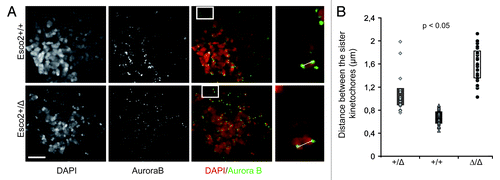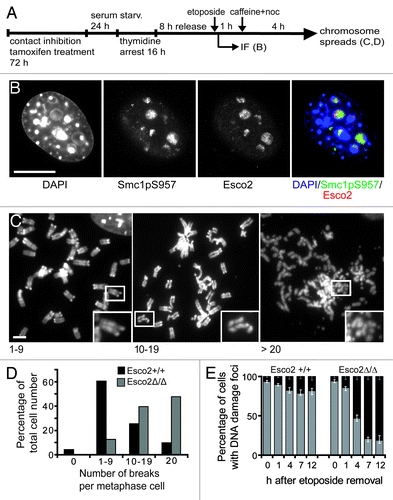Figures & data
Figure 1. Deletion in single Esco2 allele leads to measurable increase in the interkinetochore distance. (A) Prometaphase chromosomes from wild type (Esco2+/+) and heterozygous (Esco2Δ/+) MEFs were labeled with anti-Aurora B antibody to visualize sister kinetochores. Boxed areas depict a single chromosome in high magnification. The distance between the sisters kinetochores (white line), the position of which was determined by the peak Aurora B fluorescence, was measured in deconvoluted samples using Leica Advance Fluorescence software. The mean values from individual cells were plotted in graph (B). Scale bars-5 μm and 1 μm, n > 200, p value was obtained using Mann-Whitney U-test.

Figure 2. Esco2 localizes to the sites of DNA double strand breaks and is required for the efficient DNA DSB repair. (A) Experimental scheme. Esco2 was depleted in contact inhibited/serum starved MEFs by tamoxifen treatment. Cells were then arrested at the G1/S boundary using thymidine block. Eight h after release into S phase, double strand breaks were induced using etoposide (5 μM) or bleomycine (20 μgml-1) treatment. DNA damage checkpoint was blocked by caffeine (2 mM). (B) Efficiency of DBS induction was monitored by immunofluorescence (IF) using an antibody raised against Smc1 phosphorylated at S957 (Rockland, clone 5D11G5, dilution 1:50). In wild type MEFs, Esco2 localized to the sites of DBS marked with Smc1pS957 IF. Scale bar 8 μm. (C) Prometaphase chromosomes isolated from wild type and Esco2-deficient MEFs were divided into four groups according to the number of breaks: chromosomes without the breaks, chromosome spreads containing between 1–9 breaks, chromosome spreads containing between 10–19 breaks and chromosome spreads containing more than 20 breaks. Examples of prometaphase chromosomes with 1–9, 10–19 and more than 20 breaks are depicted. Boxed areas are magnified in insets. Scale bar 3 μm. (D) Esco2 is required for efficient DSB repair. The frequencies of prometaphase chromosomes with 0, 1–9, 10–19 and more than 20 breaks were plotted into the bar graph (n > 500). (E) Esco2-deficient MEFs are characterized by the persistence of DNA damage foci. DSB were induced 8 h after thymidine block release and the presence of DNA damage foci was monitored on the basis H2A.XpS139 IF (Abcam, ab22551, dilution 1:200) 1, 4, 7 and 12 h after the etoposide withdrawal. The frequency of H2A.XpS139 positive (black) and H2A.XpS139 negative (gray) cells was plotted (n > 500, per group and time point).
